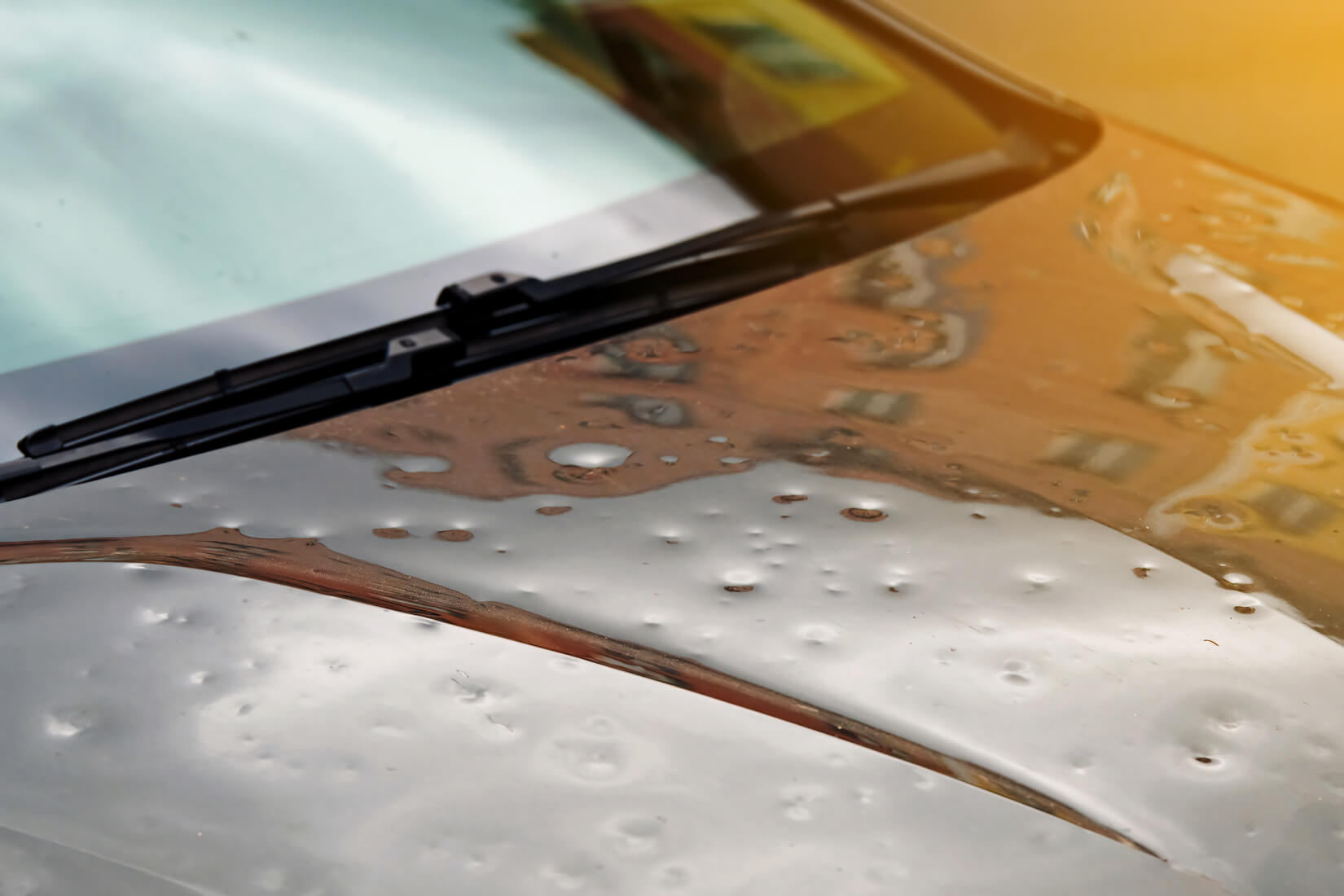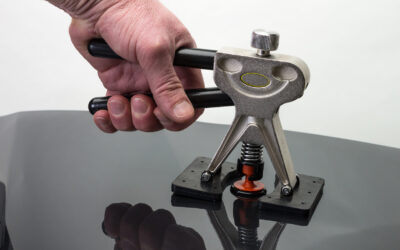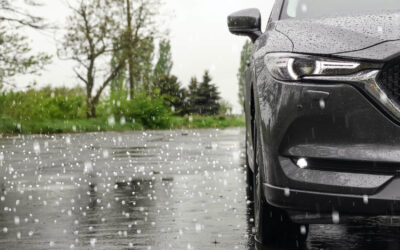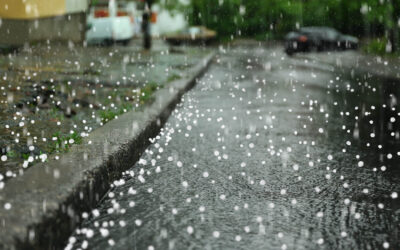When a hailstorm strikes, it doesn’t matter if your car is parked, on the highway, or tucked under a tree — dents can happen. Hail damage is frustrating and costly, and, if left untreated, can quietly reduce the value and lifespan of your vehicle. Fortunately, hail damage doesn’t have to mean repainting or lengthy shop visits.
Following a hailstorm, you’ll likely need car hail damage repair. If you’re lucky, the damage might be minor enough for you to qualify for minimally invasive bodywork. However, if the hail damage is extensive enough, you might need traditional bodywork to fix the problems.
This article explains what hail damage is, where it happens most often, and why paintless dent repair is the best way to fix it.
What Is Hail Damage?
Hail damage refers to the small-to-medium-sized dents, dings, or cracks that result when hailstones slam into your vehicle. Depending on the storm, these impacts can range from nearly invisible pockmarks to deep, baseball-sized impressions. Even a brief hailstorm can cause dozens or hundreds of dents in minutes.
What makes hail damage especially troublesome is that it’s not always obvious. Under certain lighting, you might not see the dents until weeks later. And by then, oxidation and moisture can set in, leading to rust beneath the surface.
Hail damage is also costly for vehicle owners. A recent report found that hailstorms in the U.S. caused over $2 billion in insured auto losses that year alone — and the number is climbing annually.
Hail Damage Repair Options
There are basically three repair options when it comes to hail damage repair to your vehicle. Trying to minimize damage to your vehicle and forcing a less extensive repair can cost you money in the long run. Here are your options:
Do It Yourself
You might be able to fix the hail damage to your vehicle yourself after watching a few YouTube videos, grabbing a friend and a mallet, and attempting to hammer out the dents yourself. This might be alright for two or three small dents, but anything more extensive than that, and you could run into problems. One example is overcorrecting the dent, which means pushing the original dent out too far. Once you’ve done that, the dent is worse than when you started.
Full Bodywork Repairs
You might need traditional bodywork depending on how deep the hail damage is on your vehicle. This is especially true if the paint on your vehicle has been chipped or cracked, so you’ll need a paint job after the bodywork is finished. Most motorists resist this option, because it will show up as bodywork on a Carfax report, for example, as if your vehicle was in an accident. However, this might be your only option if the hail damage is extensive enough.
Paintless Dent Repair
Paintless Dent Repair (PDR) is the preferred option for repairs because it doesn’t require sanding, fillers, or repainting — preserving your car’s original finish while keeping costs and turnaround time low. Most body shops will have PDR specialists who use specialized tools. PDR technicians gently work from behind the panel to ease the metal back into its original shape with the paint intact.
Whatever repair option you choose, it’s important to be thorough with the hail damage repairs so that the damage doesn’t creep back later down the road.
Why Timing Matters for Hail Dent Repairs
It’s tempting to shrug off hail dents, especially when they seem minor. A small dent today can become a costly repair tomorrow. Waiting gives moisture time to seep in — and rust is much harder to fix. Don’t procrastinate when repairing hail damage on your vehicle, because time will only worsen things. Getting into a body shop will prevent the following further damage:
Protecting Against Rust and Corrosion
The worst thing that can happen to your vehicle’s body after a hail storm is for the dents to break through your car’s protective paint layer, creating a vulnerable spot. Moisture can slip in, especially if the finish has tiny cracks or chips. Over time, that moisture leads to oxidation, and rust begins to form. Once rust takes hold, repairs go from simple to invasive, often requiring sanding, repainting, or panel replacement.
Preserving Resale Value
If you ever plan to trade in or sell your vehicle, visible hail damage works against you. Dents and dings signal neglect to potential buyers — even if the damage is only on the surface. A clean, damage-free body tells a better story, and that story usually leads to a better offer.
Preventing Structural Distortion
Larger or deeper dents can do more than leave marks. Over time, they may warp the underlying metal, affecting your vehicle’s alignment or handling. That kind of structural damage doesn’t just affect looks — it can impact performance and safety.
Keeping Costs Down
The sooner you repair hail damage, the more affordable it usually is. In many cases, paintless dent repair (PDR) is all that’s needed — a fast, low-cost solution. But if you wait and rust sets in or parts shift, you could be looking at a complete body repair and paint job.
Addressing hail damage early helps protect your vehicle’s value, structure, and wallet, making quick action well worth it.
What to Know About Insurance and Hail Damage Repair
If your car has been hit by hail, your auto insurance may cover the cost of repairs — but there’s often a limited window to file a claim. Most comprehensive policies include hail damage, but every provider handles it differently. You’ll likely need evidence such as photos of the damage that day and a repair estimate before they approve the claim.
If you’re unsure what your policy covers, contact your insurer immediately. A word of caution. Your insurance company might push for paintless dent repair because it’s less expensive. However, this might be the wrong choice for your vehicle, which requires complete body repair to repair the damage completely.
Hail Damage Services Are a Fact of Life in Denver
Denver sits in the heart of “Hail Alley” — the region that sees more large hailstorms than anywhere else in North America. If you live in the area, odds are you’ve either experienced hail damage already or will at some point. It’s not a question of if — it’s when.
Mile High Dents knows that whether your vehicle has minor dents or widespread damage, scheduling a professional evaluation is the best way to understand your repair options.
Paintless dent repair is often the preferred method in Colorado due to its efficiency and ability to preserve the original finish. However, you might need more extensive bodywork. Call us at (720) 772-0133 if you have any questions about the hail damage to your vehicle.
At Mile High Dents, we specialize in paintless dent repair (PDR) for all types of vehicles across the Denver metro area. Whether you’re dealing with hail damage, an annoying door ding, or a larger dent, our expert technicians restore your vehicle to like-new condition without repainting, sanding, or fillers.





